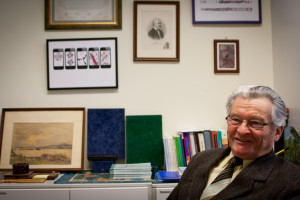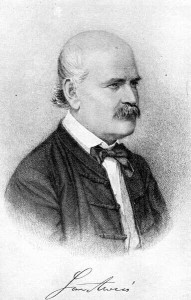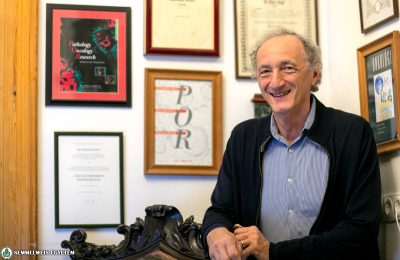Dr. Emil Monos, President of the Semmelweis Memorial Year Committee revealed that the university would open a public competition in fine arts, publish a bilingual book and organise a so-called Semmelweis night within the framework of the Researchers’ Night in honour of the Semmelweis Memorial Year. Besides, students are continuously kept up-to-date, and the Semmelweis Memorial Walks started last year continue to take place.
 The competition in fine arts, initiated by Semmelweis University focuses on the graphical depiction of Semmelweis Ignác’s personality, work and his intellectual legacy. The Semmelweis Memorial Year Committee expects dozens of paintings and graphics to be submitted by the deadline at the end of May and is planning to organise an exhibition of the best pieces. The competition is only one of the initiatives that the committee launched in connection with the memorial year.
The competition in fine arts, initiated by Semmelweis University focuses on the graphical depiction of Semmelweis Ignác’s personality, work and his intellectual legacy. The Semmelweis Memorial Year Committee expects dozens of paintings and graphics to be submitted by the deadline at the end of May and is planning to organise an exhibition of the best pieces. The competition is only one of the initiatives that the committee launched in connection with the memorial year.
The Hungarian-English bilingual memorial book titled “In Memory of Ignác Semmelweis – 150 years after his death” will have been published by autumn and will contain articles by professors of the university, as well as by Dr. Endre Czeizel and four foreign researchers. One of the authors, Dr. Constance Putnam from the USA learnt Hungarian because of her research on Semmelweis. Dr. Thomas Kenner from Austria gives an account on links between his private life and Semmelweis’. Dr. Osmo Hänninen from Finland contributed to the book with an individual article and as Dr. Emil Monos’ co-author of an article dealing with the Norwegian play written about Semmelweis. The play titled “Semmelweis” was written by Bjørneboe in 1968-69, which came to the attention of Dr. Emil Monos at an international conference: it was a present from the president of the Norwegian rector’s conference. There are several articles dealing with the history of a chalice created on the basis of the Semmelweis goblet, and the authors include Semmelweis’ great-grandchildren Dr. Kálmán Hüttl and Dr. Tivadar Hüttl. The foreword is written by Rector Dr. Ágoston Szél and the epilogue is written by Dr. Miklós Réthelyi rector emeritus and president of the Hungarian UNESCO Committee.
The Semmelweis Memorial Walks with Hungarian and English guides are continued within the framework of the Memorial Year organised jointly by the Association of Friends and Semmelweis Alumni. The tours aim at grasping Semmelweis’ importance as the saviour of mothers and infants, therefore this year’s first walk started from the 1st Department of Paediatrics and proceeded on to the 1st Department of Obstetrics and Gynaecology, once led by Semmelweis.
The Committee considers it very important to keep students up-to-date; the first lectures of the first semester dedicated a few minutes to the significance of Ignác Semmelweis and the events of the Memorial Year. Informative presentations are broadcast during the breaks between lectures on the screens in the lecture halls of the NET building and the Basic Medical Science Centre.
According to the plans, Ignác Semmelweis will be an important part of this year’s Researchers’ Night, as the university is preparing to introduce a stand-alone programme on Semmelweis.
 Dr. Emil Monos pointed out that Ignác Semmelweis embodied great values by his simple but groundbreaking discovery. He himself has been attracted to the history of medicine since he was a university student, and was awarded by an honorary medal issued by the Hungarian Medical History Society for his publications on Semmelweis and other relevant works. Dr. Emil Monos said that he was in several ways linked to Semmelweis for example through his area of expertise, clinical pathophysiology, which Semmelweis had been a pioneer of.
Dr. Emil Monos pointed out that Ignác Semmelweis embodied great values by his simple but groundbreaking discovery. He himself has been attracted to the history of medicine since he was a university student, and was awarded by an honorary medal issued by the Hungarian Medical History Society for his publications on Semmelweis and other relevant works. Dr. Emil Monos said that he was in several ways linked to Semmelweis for example through his area of expertise, clinical pathophysiology, which Semmelweis had been a pioneer of.
The main patron of the Semmelweis Memorial Year Committee, numbering ten members is Dr. Ágoston Szél, Rector of Semmelweis University. The patrons are Dr. Miklós Réthelyi rector emeritus and president of the Hungarian UNESCO Committee and Dr. Benedek Varga, director of Semmelweis Museum. The members of the Memorial Committee are Dr. Éva Kovács, Dr. Frigyes Kőnig, Dr. Zsolt Melczer, Dr. László Molnár (secretary), Dr. Emil Monos (president), Dr. János Rigó, Dr. Imre Romics, Dr. László Rosivall, Dr. Péter Sótonyi, Dr. László Táncos.
2015 became the International Semmelweis Year after UNESCO’s General Conference accepted the recommendation of the Hungarian National Commission for UNESCO to include the 150th anniversary of Ignác Semmelweis’ death in the list of notable anniversaries celebrated in 2015.
Pálma Dobozi
Translated by Ágnes Raubinek
Photo: Attila Kovács – Semmelweis University


